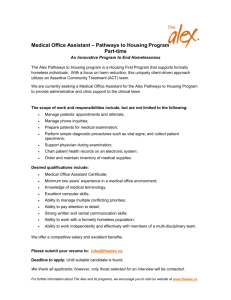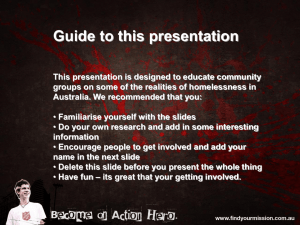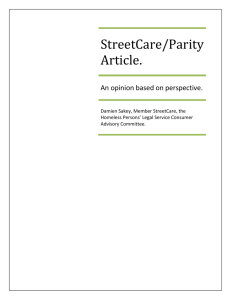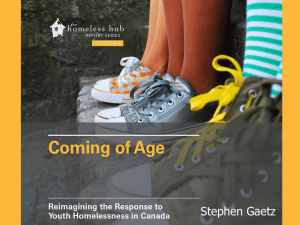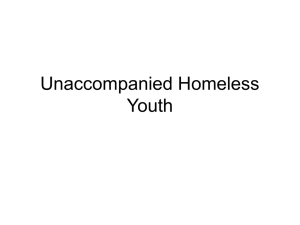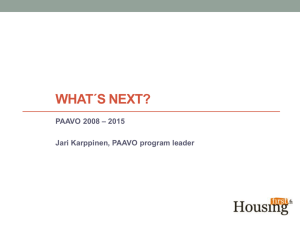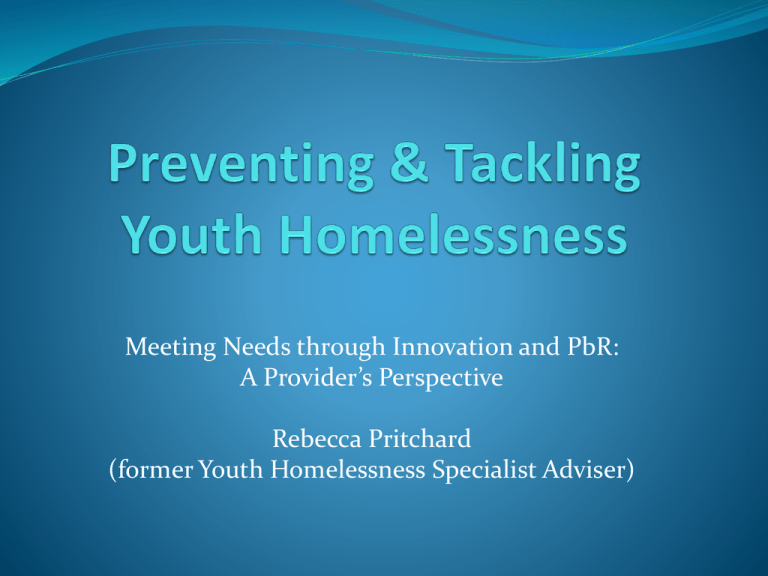
Meeting Needs through Innovation and PbR:
A Provider’s Perspective
Rebecca Pritchard
(former Youth Homelessness Specialist Adviser)
About Kipper
Small, specialist local providers: 30+ years experience
of working with young homeless people in the East
End
Supported housing offer – focused on enabling
transitions to independence , Education, Training and
Employment specialist support and mediation
Board support for innovation and informed risk taking
in recognition of challenges and increasing pressures
faced by young people which require new responses
Context
Cuts in public expenditure
Youth unemployment at its highest level in 20 years: (Homeless Link
“Young & Homeless 2013”; January 2014).
Lack of affordable housing - increasing numbers of young people
remaining in childhood homes into their 30s – but not always feasible
if overcrowding, poverty and violence an issue**
Local authority services increasingly focused on those where a
statutory duty is owed, rather than addressing needs regardless of legal
status
Welfare Reform
High risk of financial exclusion if young people don’t comply and
engage with job seeker requirements
Reduced options for young people in terms of move on into PRS –
greater competition; SAR & LHA caps reduce options**
Greater demand for smaller units for downsizing as a result of the
spare room subsidy – reducing affordable move on
Homelessness Acceptances for Young People – to whom a statutory duty is owed
Cliff edge
Homeless 16- 17 year olds
Homeless 18 – 24 year olds
Anxiety & depression (52%)
We don’t know, but...
Involvement in crime/ ASB (39%)
Needs and vulnerabilities don’t
Substance misuse problem (37%)
Exposed to violence in the home
(40%)
Been on child protection register
(12%)
(DCLG 2008)
Statutory responsibility to provide
housing and support – Children’s
Services and Housing
disappear on 18th birthday
Research into entrenched rough
sleepers found sofa surfing,
street drinking, needs led
offending, custodial sentences
and IV drug use occurred
between 18 – 21 years
(DCLG 2012)
No statutory responsibility to
provide ( unless care leavers)
Multiply-excluded rough sleepers:
Experience
Percentage
Used solvents, gas or glue
Left local authority care
Thrown out by parents/carers
Had sex or engaged in sex act in exchange for money, drugs, etc.
23%
16%
36%
10%
18
19
20
Involved in street drinking
Used hard drugs
Had a period in life when had six or more alcoholic drinks on a
daily basis
53%
44%
63%
20
Stayed with friends or relatives because had no home of own
77%
20
Shoplifted because needed things like food, drugs, alcohol or
money for somewhere to stay
38%
20
Were a victim of violent crime (including domestic violence)
43%
21
22
Went to prison
Had a period in life when very anxious or depressed
46%
79%
22
26
26
Injected drugs
Slept rough
Admitted to hospital because of a mental health issue
27%
77%
29%
median age of first
occurrence of common
experiences
15
17
17
17
Fitzpatrick, S., Bramley, B. & Johnsen, S. Pathways into Multiple Exclusion Homelessness in Seven UK Cities,
Urban Studies, 2013
Unmet needs and poor outcomes
In London, 719 people aged 18-25 were seen rough
sleeping in the year to March 2013, compared with 624
in the previous year. http://www.broadwaylondon.org/CHAIN/Reports/StreettoHomeReports.html
Homelessness a risk factor for young people – leading
to increased long term negative outcomes: poor
emotional/ mental health (BMA 2003); lower
academic achievement; increased risk of insecure low
paid jobs or unemployment; long term homelessness
(Shelter 2006).
Positive Pathways for Young People
1. Minimise
Demand:
Education work
in schools /other
places on reality
of housing
choices
2. Reduce
Demand & Crisis
3. Reduce/ Avert
Crisis
Early intervention
targeted to keep
young people in
family network
Plan & prepare
with those at risk
of homelessness
BEFORE they are
in crisis
5. Supported accommodation
as a starting point for those with
higher needs or younger age
(16/17)
8. Young person is
ready to make
their next move
with minimal/no
support and is
positively engaged
in ETE
6. Floating Support in
accommodation - likely to be
shared in private rented sector
7. Shared student style
accommodation for those in FE,
employment or apprenticeship
with “light touch” support
4. Single Integrated
Service Gateway
Prevention, assessment
of need, planning advice
& options
AND access to other
services e.g.
ETE & Job Centre Plus
Range of health services
Life skills
Benefits advice
Steps 5-7
Young people can
access 3 broad
options and move
between them until
they are ready to
move on.
Challenges to current models
Pathways not always established/ gaps remain
Services challenged to cater for all levels of
need/supervision required – not always able to meet the
highest needs groups or flex outside service specifications
Re-tendering forcing a rush to the bottom? Loss of skills
from the work-force...
Increasing levels of need and risk seen in the YP we work
with, but pressure to reduce the length of stay for young
people in - expected to do more with more complex young
people in less time
Unrealistic expectations continue regarding housing
options from YP – can lead to disengagement if housing
the focus
Need for new responses?
Traditional supported housing models - being tested by
greater complexity and risk profiles of young people:
Complexity of needs – challenging behaviour, substance
misuse and related dealing, risk taking, vulnerability,
communication difficulties
Gangs, history of violence
Excluded from services – nowhere left to go...?
Return home – not always safe; may precipitate future crisis &
rupture with family
Sofa surfing
Adult homelessness services – not always suitable for YP
Rough sleeping
Offending – criminal justice system “accommodates”
Uncertain futures...
Zac – 19 years olds; moved
into supported housing for
young homeless people;
suffered from drug induced
psychosis; sectioned 3 times;
set fire to flat; had to leave;
older sister sent him home to
family in Bangladesh; he
returned but only option is
large hostel for adult men...
Dave – 20 years old; had
offending history and started
drug dealing; not placed; left
to sofa surf with “friends” and
acquaintances...
Baz – 19 years old; vulnerable
and immature; lacked insight
into his behaviour and had
history of assault; not placed
– ended up in a 150 bed hostel
for adult men with no young
person focused support...
Fred – 21 years old; significant
cocaine and cannabis use
(£300+ per week); posed risk
to other young people and
self; not placed – struggled on
at home until ended up in
custody...
Need for creativity
Young people say its..
The importance of the
relationship
‘Stickability’ of the key
person/people
People doing what they
say they will
Workers being realistic
and challenging
But also being positive
even when it gets tough
Agencies say its…
Small caseloads
Personalised approach
Highly skilled staff
Access to specialist
therapeutic services
Access to affordable
housing
Being creative
Focusing on positives
Opportunities
to innovate
Prevention
Intensive work
to enable YP to
stay at home
Contingency
Management
Incentivise
engagement
and outcomes
for the YP
Social Capital
Proactively
building
support
networks and
creating capital
for the YP &
whole family
Work First
Underwrite PRS
rent shortfalls
for agreed
period to
establish YP in
work
Psychosocial
Interventions
CBT, coaching,
counselling...
Young
Person
Personalised
Budgets &
Brokerage
Reconnections
Fresh starts
with intensive
resettlement
support
Creative
responses
enabled (safe &
legal) to achieve
outcomes
Adding
Capacity
Additional
support into
existing
services
Housing First
Models of
intensive support
in s/c
accommodation
PbR Partnerships: Unlocking Potential transforming outcomes for young people
Social
Investors
enabling innovation
& flexibility
Local
Authorities
referrals &
pathways
YP
Providers
engagement
expertise &
creativity






